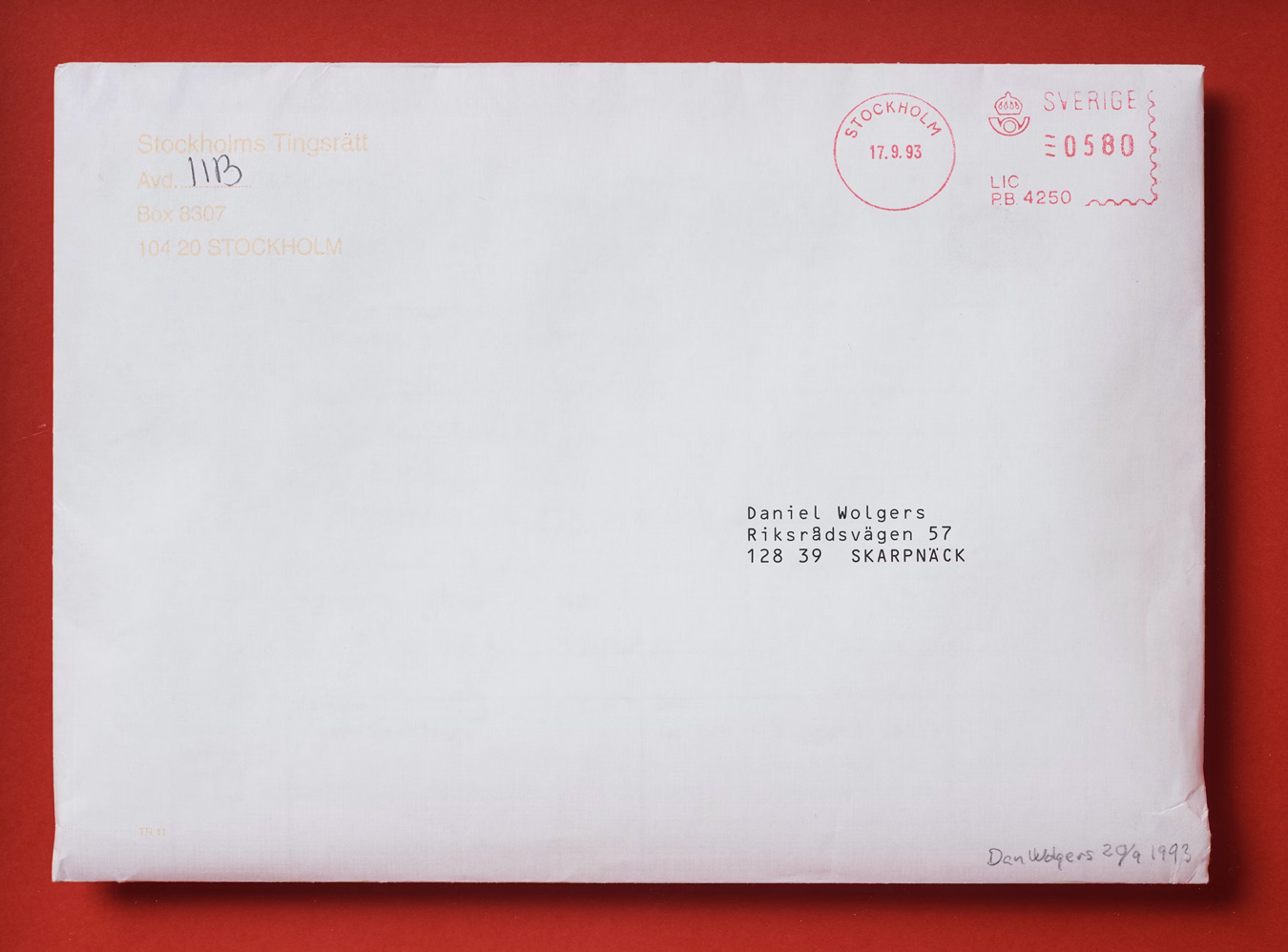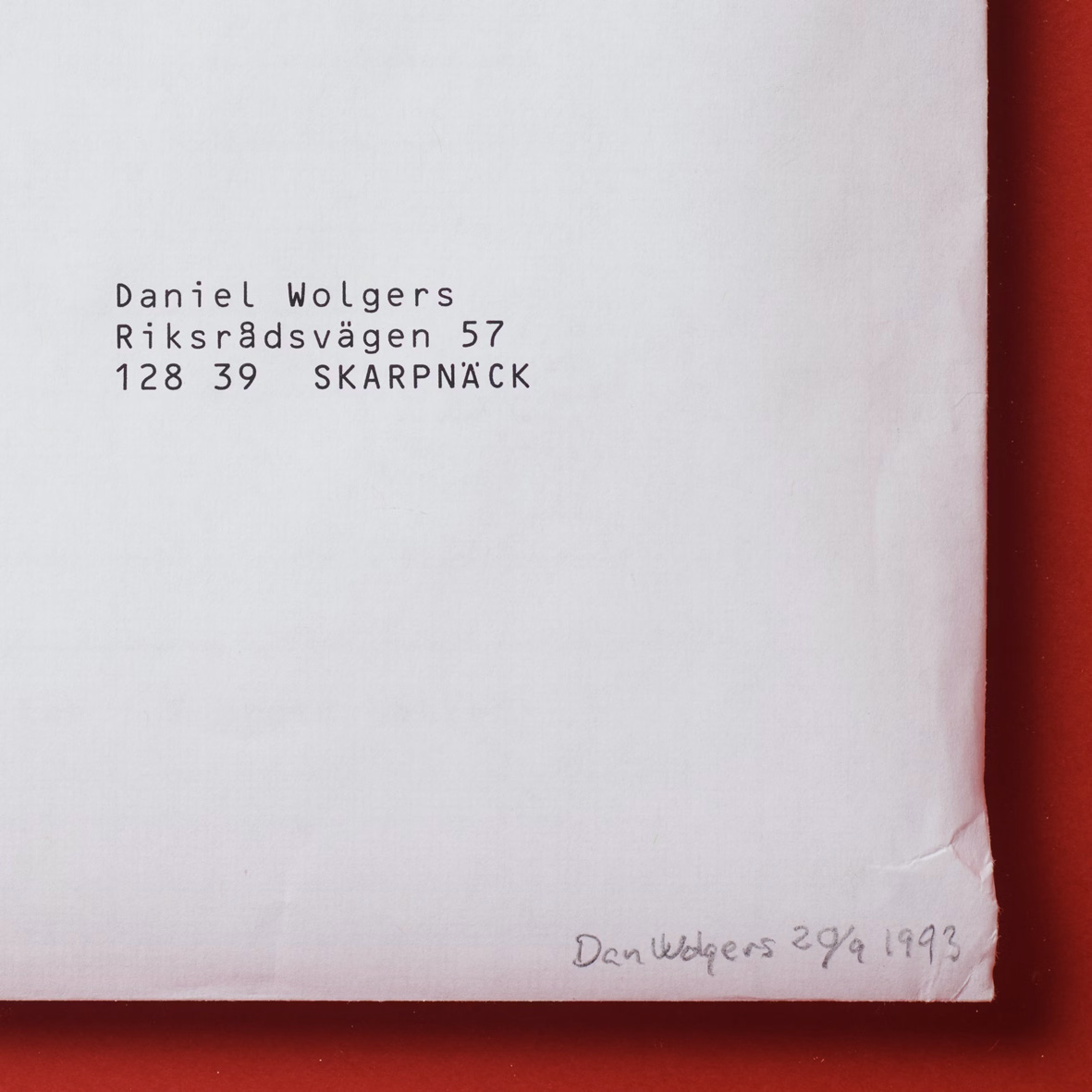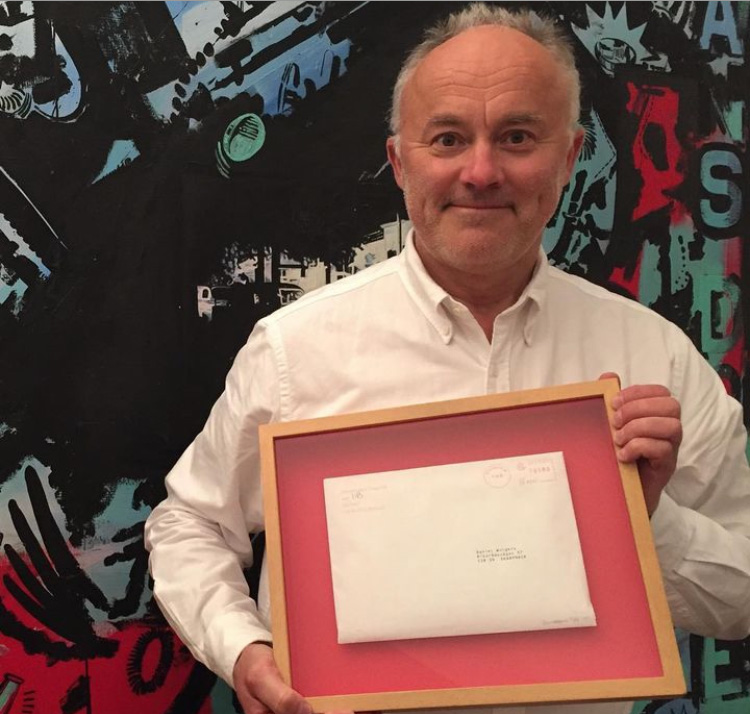"The Verdict" by Dan Wolgers from the Tom Böttiger Collection
Dan Wolgers
"The Verdict"
"The Verdict" is one of Dan Wolgers' most renowned artworks, and it secured its place in Swedish art history the moment it was signed. However, simultaneously, it was torn from its actual context and into its realm, where myth and reality gradually merged. Here, Dan Wolgers has, in his own words, compiled the background to this legendary ready-made:
In the spring of 1992, Liljevalchs invited about twenty Swedish artists to participate in a group exhibition scheduled to open in November of the same year. The exhibition was titled "Se människan," which translates to "Behold the Man," the words Pontius Pilate uttered when he presented the scourged Jesus to the roaring crowd just before the crucifixion. It is tempting to interpret the title as if the art hall considered itself to be presenting (consecrated) art to an uncomprehending audience.
For the vernissage, an exhibition catalog was to be compiled with a simple presentation of the participating artists. I accepted the invitation, aware of the conditions regarding exhibition compensation that prevailed at the time. The concept of exhibition compensation did not exist yet (it wasn't until 2009 that the so-called MU agreement was signed between the state and several artistic organizations). In 1992, and probably still in practice, artists negotiated individually with the organizers (in this case, Liljevalchs) and competed with each other for compensation until the exhibition's meager budget was exhausted. Those who received grants could get one or two thousand Swedish kronor. Still, typically, the organizer claimed that it was sufficient compensation for the artists to have the opportunity to exhibit their works for free. In practice, the artist at the bottom of the chain funded the art hall's mission to showcase art to the public with their money and labor.

I decided that I wouldn't subject myself or the exhibition commissioner to humiliating negotiations for money this time.
In the art hall, there were, and still are, about a dozen benches for visitors to sit on. I informed the exhibition commissioner that I needed two benches for my participation and received his help, without questions or objections, in carrying both benches to my car outside the main entrance. In my studio, I tidied up the benches, removed the carpentry labels inside the frame, and scraped off hidden chewing gum (the labels are now in the Moderna Museet's collections). After that, I transported the benches to a photo studio for the image in the exhibition catalog and then directly to submission and display at Stockholms Auktionsverk, which was located in the heart of Stockholm then. The submission date was synchronized with the vernissage so that the auction day would fall before but as close to the vernissage day as possible, and luckily, it ended up being only a few days apart. It was crucial for me that even though I hadn't fully disclosed what I intended to do for the exhibition (because what artist does?), the sale of the benches should still be as open as possible, and what's more open than an auction right in the city center? As the auction day approached, I received a call from the exhibition commissioner, who urged me to call back with a severe and concerned tone. I assumed that someone in the art hall's management had accidentally seen the benches on display and, to gain time had refrained from calling back. Finally, after repeated prodding, I found it unsportsmanlike to delay the call further and called back. Then, I was informed that the art hall had plagiarized my telephone directory cover for the exhibition catalog's cover, which was in every home and workplace that year. The art hall had replaced all the details with their own. But now they were remorseful and concerned about what they had done, now that the finished catalog had finally been printed and delivered to the art hall. I burst out laughing, and when asked what was so funny about the news, I replied, "You'll see!"

It wasn't until the exhibition was entirely hung the day before the vernissage, the benches had been sold, and my space in one of the halls remained empty, that I informed the management that my contribution to the exhibition was that I had, by auctioning off the benches, arranged compensation for my efforts. I had nothing more to contribute than the sign on the wall, which marked my vacant space, even though the sign had been put up by the art gallery and not by me (the sign was stolen a few days later). The management reacted with delight to my contribution and treated me to lunch and dinners to discuss the matter further, as it had spread to the media during the press preview and caused quite a sensation.
A few days after the vernissage, the art hall was contacted by the buyer of the benches, who had seen where they came from in the press. They were now in a hair salon for customers to sit and wait on, and there was a picture of it in the newspaper. The hair salon offered to sell the benches back to the art hall and received a significantly higher price than what I had received at the auction a week earlier.
When the payment from the Auction House arrived, I bought a fax switch, a device that could distinguish between fax and telephone calls in incoming calls to the studio. It was a timely purchase because I received hundreds of calls daily in my studio due to my telephone directory cover—much of the preparation for the benches involved linking potential developments together as much as possible. For example, any income from the sale of the benches would be reinvested in artistic activities. Therefore, I had decided in advance to purchase the fax switch, but the peculiar thing was that the fax switch cost the same as the benches had finally yielded. Only chance could have arranged this, as it was not possible then, before the digital age, to find a product on the market with a specific price. The receipt is in the Moderna Museet's collections, and the fax switch is in my possession.

Since I had requested that the benches not be placed back in my completed space in the art hall, they were placed in another artist's room on a raised pedestal with a surrounding rope, and the whole thing was surrounded by piles of press clippings about the benches.
During the exhibition, when visitors came to see my empty space and the nail holes from the stolen sign, and the repurchased benches on the catafalque, I was reported to the police by two private individuals, independently of each other. My offense fell under public prosecution, and the prosecutor determined the charge to be embezzlement. I was called in for questioning, provided a detailed account of the factual circumstances, and admitted guilt. Eventually, a trial followed for which I had been assigned a publicly funded defense attorney, but neither of us had anything to add. In the courtroom, there was a school class and some art connoisseurs. The verdict would be delivered at a later date.
And sometime later, I read in the morning newspaper at breakfast that I had been sentenced to sixty daily fines for embezzling the two benches. The sentence was considered lenient, and the reason for leniency was that I had no previous criminal record and was not expected to relapse into crime. Later that same day, a letter from the Stockholm District Court arrived by mail. I assumed it contained the verdict and a payment slip for the fine amount. Since I would soon have a solo exhibition at Galleri Riis in Oslo but lacked the funds to execute what I had planned for the exhibition, I decided to ask the gallery owner to try to sell the unopened envelope to a collector. It worked, and I signed and dated the envelope with today's date, awaiting a reminder invoice regarding the fines from the district court. When the reminder arrived, I paid the fines with the proceeds from the sale, and the surplus amount went towards preparing the exhibition in Oslo.
After it became known through the newspapers that the unopened envelope had been sold, and the proceeds had gone toward fines and the next exhibition, the media frenzy lost interest as it could no longer keep up with the twists and turns.
I moved on, and so did the envelope in its way.
Dan Wolgers

› Tom Böttiger caught on camera after acquiring Dan Wolgers' "The Judgment," 2016.
The work will be sold at Tom Böttiger Collection
For requests & condition reports Contact our category specialists

Stockholm
Louise Wrede
Head of Art Department, Specialist Contemporary Art, Private Sales
+46 (0)739 40 08 19

Stockholm
Karin Aringer
Head Specialist Contemporary Art and Photographs
+46 (0)702 63 70 57



























